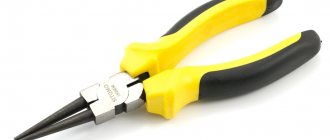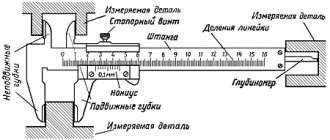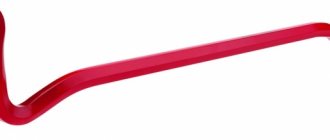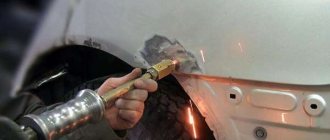A rack vibrating compactor, better known as a vibrating lath, is a tamping tool, the use of which can improve the quality of concrete laying.
Modern models feature an ergonomic design that allows the operator to work for a long time with high productivity.
Depending on the operating conditions, different types of this tool are used, and the buyer has access to virtually universal vibrating screeds with the ability to adjust operating parameters.
Purpose and principle of operation
Vibrating screeds are used in the construction industry for distributing, compacting and leveling cement mixtures or concrete.
This work is necessary in the process of pouring roads, floors, and various concrete sites.
As you know, the durability and reliability of the entire building directly depends on the quality of the concrete coating, therefore the rack vibratory compactor plays an important role in its formation.
The main advantage of a vibrating screed is the ability to produce screeds based on solutions containing no more than 20% water, that is, from dry mixtures.
As for compaction, the tool is capable of effectively compacting the concrete mass to a depth of up to 300 mm.
Basically, the vibrating screed is used on fresh solutions that have not had time to dry.
The principle of operation of the tool is the vibration effect of its working part on the concrete solution, due to which the latter is evenly compacted with the formation of a smooth surface.
Examples from the catalog
The electric vibrating screed VPK SKAT E (floating) is used when leveling a concrete floor. Using a tool helps create a perfectly level surface. The replaceable profile allows you to work in different areas. At the client's request, slats up to 4 meters long are installed. Suitable for working with concrete surfaces and screeds made from semi-dry mixtures. The vibrating screed profile is made of a special alloy that does not deform during operation. Ergonomic design ensures ease of control. The tool operates from a 220 V network.
The P-35A WACKER petrol engine driven vibrating screed is used for leveling, spreading and compacting concrete surfaces. The model comes with a HONDA drive and a set of aluminum profiles of different lengths. Light weight, folding handle and special handle on the motor facilitate easy transportation and quick installation of the tool.
The double vibration compactor RVM of the Skat series is equipped with an electric motor powered by a 220 V network. The tool is suitable for work in enclosed areas. The Skat model range is equipped with a built-in vibration unit, securely attached to the profile. The design ensures stability of vibration forces, promoting uniform compaction of the surface to a depth of up to 300 mm. For the manufacture of slats, a lightweight aluminum profile with a height of 100 and 180 mm is used. Models are supplied assembled and as separate components. Additionally, it can be equipped with a functional handle with a control unit. There are no analogues in Russia.
Device and characteristics
A standard vibrating screed is a rigid structure, the main parts of which are:
- Metal strip (blade, profile, rule) - the working part of the tool, which is in direct contact with the surface being processed, differs in design and size for different models. On sale you can find blades of various lengths, shapes and materials for many models of vibrating slats.
- Vibrator unit is the driving part of the tool, consisting of a frame with two handles, through which the motor and vibrator are controlled, converting rotational movements into vibration ones.
Industrial vibrating screeds do not differ in operating principle from manual models, however, for ease of transportation they have a collapsible design.
In addition, in standard models the engine is always installed in the center of the structure, while in industrial models the engine is located either on the edge of one side, or several vibration units are evenly placed along the entire length of the device.
Types of profiles
Modern vibrating screeds are equipped mainly with two types of profiles:
- Double-rack systems have 2 parallel slats made of a U-shaped profile, fastened together into a rigid structure with tubular clamps.
- Single-rack models have only one large-width rail in their design, made in the form of a channel.
Aluminum vibrating slats, that is, tamping slats equipped with an aluminum profile, are used mainly where increased demands are placed on the level of the treated surface (freshly poured concrete).
Depending on the tool model, L-, U- and Z-shaped profiles are used, as well as box-section options that provide sufficient structural rigidity.
Aluminum blades often have rounded edges, allowing the machine to move easily while working.
Material
The working frame of vibration equipment is made of steel profiles of various section shapes.
The materials for the slats are also steel and aluminum.
The handles of manual models are structurally part of the frame, made of hollow steel pipe, and can be equipped with rubberized pads for ease of use.
Dimensions, weight of vibrating screeds and compaction depth
The dimensions of vibrating screeds, as well as their performance characteristics, directly depend on the type of equipment.
The length of the working part can be from 1.2 to 25 m, but often does not exceed 4 m, the profile width is from 50 mm (usually 200 - 250 mm for floating models), the height is on average 1000 - 1200 mm.
Vibrating screeds are capable of compacting the solution to a depth of 12–30 cm, and weigh generally 15–80 kg.
For sectional options, only one section can weigh 30–80 kg, and drives 110–150 kg.
Engine type and power
Vibrating screeds are equipped with one of the following types of motors:
- Gasoline 2 or 4 stroke engine, the power of which is usually 1000 - 5500 W.
- Electric 42 V, 220 V or 380 V. In the first and second cases, the motor power is usually 100 - 1100 W, in the third - 2.5 - 5 kW.
NOTE:
There are also pneumatic options connected to compressor equipment.
Number of vibrators and vibration frequency
Standard vibrating screeds are equipped with one vibration unit.
The optimal operating mode of the equipment is determined using a special sensor (if installed).
The lower the movement speed and the higher the oscillation frequency, the lower the productivity, but the higher the achieved mixture density.
Using the tool, the 7-day strength of concrete is formed in just 24 hours of work.
The vibration frequency can vary greatly from model to model, usually in the range of 2500 – 9000 vibrations per minute.
NOTE:
Industrial units may have several motors and vibrators, depending on the number of sections.
Operating time without refueling
The continuous operation time of a tool with a gasoline engine depends on fuel consumption and the capacity of the fuel tank.
Floating models usually require refueling after an hour of operation.
Recommendations for use
Gasoline and electric vibrating screeds operate on a similar principle, and the rules for handling the devices are also similar. Before starting work, you should read the technical documentation supplied with the equipment.
In the list of recommendations for use:
- Mandatory periodic inspection, during which the condition and reliability of fastening of the vibrator and other structural elements are checked. Equipment that has not undergone maintenance is not permitted to be used under any circumstances.
- Checking the condition of the room where the electric vibrating screed will be used. The enclosed space must be well ventilated. Working with a vibration compactor is prohibited in conditions of increased atmospheric pollution with gases or dust, as it can lead to insulation failure. An electric vibrating screed has a significant advantage: it can be used with weaker ventilation. To use a tool with a gasoline engine, you need powerful air purification.
- Before you start working with an electric vibrating screed, you will need to check the condition of the electrical wiring in the room, this will help to avoid problems and short circuits.
- The condition of the vibration compactor cable should be monitored. It is strictly forbidden to have kinks on the wire or twist it into loops.
- To work with an electric vibrating screed, the operator will need protective clothing, first of all, special helmets and headphones. Such devices allow you to avoid the effects of noise on the human body.
- Work with the tool should be carried out in protective glasses, gloves and shoes. The requirements are due to the fact that gravel or cement that bounces off the surface can cause injury to a worker.
Types of vibrating slats and their prices
Vibrating slats are used both for compacting the poured mixture to a certain depth and for leveling its surface.
To work in different areas and under different conditions, equipment with appropriate characteristics is used.
Depending on the type of drive motor, vibrating screeds are divided into:
Electrical
Can only be used when connected to the network.
Among the differences, it should be noted the relatively low weight of the vibration unit, the possibility of indoor use, low power, dimensions and weight, with the exception of sectional versions.
The cheapest models will cost 10 thousand rubles.
Gasoline
The models are larger and heavier vibration machines than the previous version, which can only be used outdoors due to the release of combustion products during operation.
On the other hand, the design with an internal combustion engine is completely autonomous and does not depend on the network.
Cost from 40 thousand rubles.
According to the method of application, vibrating screeds are divided into:
Floating
Capable of processing up to 3 - 5 meters of working plane width, compacting material to a depth of 150 - 180 mm.
To begin work, place the tool on the poured or laid solution, after which it is moved towards you.
Models with replaceable profiles, often made of aluminum, have become widespread.
This allows you to install a profile of the required length and simplifies transportation.
Assembled surface models usually weigh about 15–25 kg; such a small weight can be easily handled by one operator.
The price tag starts from 20 thousand rubles, and can exceed 100 thousand.
Models with guides
They are used to smooth out rough irregularities and can act on a layer of concrete up to 300 mm thick.
First, the guides are set strictly in compliance with a certain level and angle, only after that the solution is poured.
During operation, the vibrating screed is placed on prepared guides and slowly moved at the optimal speed for leveling the surface.
Pulling is usually done using the lugs located on opposite sides of the working rail.
The principle of operation can be compared to plastering a wall using the beacon rule, but with a rather serious vibration effect.
Price from 12 thousand for models with a solid profile.
According to their purpose, vibrating screeds are divided into:
Double
Options for concrete - for compacting and leveling concrete surfaces using guides.
Structurally, the working part of the tool consists of two parallel profiles of mainly rectangular cross-section, fixedly connected to each other by rigid clamps, which forms a kind of frame.
Such equipment moves along guides, and due to a pair of profiles, it allows only one pass.
Finishing (vibrating mops)
Designed to work without the use of guides, this is the floating version.
Grout models
Tamping equipment is considered conditionally due to the specific functionality; it is used at the final stage of work to eliminate unevenness on concrete surfaces.
According to the type of working profile, vibrating screeds are:
Hard
Fixed length, which usually does not exceed 3 m (there are exceptions), otherwise there will be serious inconveniences during transportation between objects.
Cost 20 – 40 thousand rubles.
Telescopic
Rectangular frames with sliding slats, which allows you to level a large area of mortar in one pass.
Before starting work, the model is laid out to the required width.
Sliding models are more convenient to transport due to the fact that their length when folded is reduced by almost 2 times.
Cost 25 – 50 thousand rubles.
Sectional
The main purpose is work in industrial construction.
The required length of the slats is selected from frame sections of 1 - 2 meters in stationary conditions.
The total length of the assembled sections can reach 25 m.
These models can compact down to a depth of 120mm.
Reversible
It has a box-shaped profile with edges rounded on both sides, which allows you to compact concrete by moving the unit both “toward” and “away”, in contrast to the same L-shaped profile.
The leveled and compacted surface is usually treated with trowelling devices.
How to choose a vibrating screed?
A vibrating screed is a rather expensive professional tool.
Although the model line of some manufacturers includes a budget series of equipment, for private construction or for small volumes of work, renting tools will be optimal.
Craftsmen who are busy filling areas with concrete will need a good professional vibrating screed.
If we talk about floating models, the best option would be one with replaceable blades.
Its advantages include the ability to select the required width within a fairly wide range, as well as ease of transportation.
For the same reason, you should look towards telescopic frames when purchasing equipment for guides.
If you plan to work on electrified objects, electric vibrating screeds are advantageous, since they can be used both outside and indoors.
NOTE:
The main disadvantages of 220 V models (for household power supply) lie in their higher cost than 42 and 380 volt models, and when compared with gasoline equipment, the wire is of limited length. On the other hand, 42 V vibrating laths require additional equipment in the form of a step-down transformer, and 380 V devices require a three-phase industrial network.
The choice of vibrating screed should be made taking into account the type and volume of work to be done, of course, priority is given to models with the ability to adjust the width of the working profile.
Also a good addition would be to adjust the vibration frequency and driving force.
In addition, you should take into account the required productivity, the duration of the working season, the location of operation, and the availability of high-quality service support.
Making the right choice
In order for the efficiency of the work performed by the vibrating screed to meet the required level, it is necessary to select this unit according to the following characteristics:
1. By the mass of the working beam - the depth of concrete compaction depends on this indicator. The greater the density of the concrete, the greater the weight of the working beam will be required.
2. According to the amplitude of vibrations of the working frame - the optimal amplitude of vibrations of the frame is selected taking into account the height of the rack and the frequency of vibrations.
3. In terms of the speed of operation of the unit - better work results can be achieved with slow movement of the vibrating screed in combination with more frequent vibrations.
As for choosing the price of the unit, everything depends primarily on the manufacturer. Naturally, professional devices that are regularly used on large construction sites will be more expensive. A small vibration screed used for periodic work will cost less.
What you need to know about vibrating screeds?
Although vibrating screeds are easy to use, when working with them you should follow some operating rules:
- Working with electric tools requires the use of rubber gloves and boots to avoid electric shock.
- Before starting, the tool must be checked for serviceability.
- Heavy vibratory slats are mounted on the guides before the mixture begins to be supplied, and the guides themselves are installed strictly in a horizontal plane along a mark indicating the calculated height of the solution being poured.
- If during the broaching process areas with sagging areas are found, they are filled with solution to the required level.
- After work, the tool must be completely cleaned of the solution, especially those parts that were in direct contact with the concrete.
NOTE:
If any defects are observed after the concrete mixture has hardened, they can be easily eliminated with a grinding machine.
Features of using the device
A vibrating screed is a device that passes over the surface of the concrete being laid and performs several important tasks at once:
- Tamping the mixture, making the future coating more durable.
- Compaction of the solution - it contains a large amount of air impurities that require removal.
- Leveling the surface.
As a result, the structure of the concrete surface will be of higher quality and more durable.
This treatment of concrete makes it possible to achieve good performance characteristics of the future coating and remove possible voids, water and air bubbles from it. After vibrating lath, the coating is completely ready for finishing: laying tiles, laminate, linoleum, heated floors and other options.
The product is used in private construction and on an industrial scale.
With its help, the following are built:
- bridges;
- hydraulic structures;
- overpasses;
- floors;
- blind areas;
- foundations and other similar objects.
Vibrating screed can be used for a large number of structures











